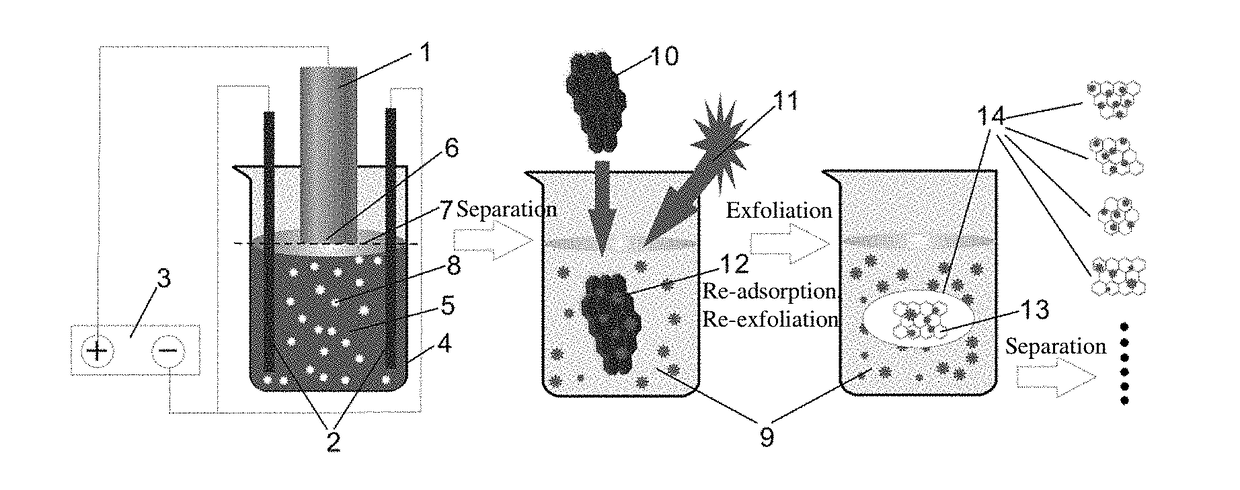Graphene oxide quantum dot, material composed of same and graphene-like structure, and preparation method therefor
a graphene oxide and quantum dot technology, applied in the field of nanomaterials, can solve the problems of limiting the application of graphene oxide in electronic devices such as transistors, limiting the large-scale production of graphene oxide, and limiting the use of organic solvents with a high boiling point such as n-2-methylpyrrolidone or n,n-dimethylformamide, so as to achieve the effect of suppressing refolding
- Summary
- Abstract
- Description
- Claims
- Application Information
AI Technical Summary
Benefits of technology
Problems solved by technology
Method used
Image
Examples
example 1
[0048]T300 12K (12,000 single filaments) polyacrylonitrile-based carbon fiber bundles were used as the starting material. Single filaments of the carbon fiber have a diameter of 7 μm, and are composed of microcrystalline graphite layer structures, wherein the orientation of the microcrystalline graphite layers along the fiber axial direction was at an angle of about 80° with respect to the tip face of the carbon fiber. The tip faces of 78 such carbon fiber bundles were cut together such that they were aligned, and these cut bundles were vertically placed above an electrolytic cell containing an aqueous solution of 0.5 M sodium hydroxide and were connected as an anode to the positive electrode of a DC power supply; a SS 304 stainless steel mesh having an area of 100 cm2 was fully immersed in the solution and connected as a cathode to the negative electrode of the DC power supply; before electrification, the aligned tip faces of the carbon fiber bundles were carefully adjusted to be i...
example 2
[0051]Example 2 differs from Example 1 mainly in that: a 1 mm-thick graphite plate was used as the starting material, and the 2D orientation of its graphite layers was perpendicular to the working end face of the graphite plate anode; the electrolyte solution used was 0.5 M ammonium carbonate; an aqueous solution of ammonium carbonate containing GOQDs was obtained; then graphite debris and ammonium carbonate were removed from the solution by filtration and subsequent pyrolysis, to finally obtain a solution of GOQDs having a thickness less than 2 nm, a particle size distribution in a range of 10 to 25 nm, a carbon / oxygen atomic ratio of 2:1, and a concentration of 2 mg / ml. To 1 L of the solution of GOQDs obtained above (2 mg / ml), 10 g powder of boron nitride was added, and treated by sonication for 2 h (for sonication, the working frequency was 20 kHz, and the power was 600 W), to dissociate and cut the powder of boron nitride to generate a composite nanomaterial formed by quasi-two ...
example 3
[0052]Example 3 differs from Example 2 mainly in that: the graphite-like structure used was powder of tungsten disulfide, which was treated by ball milling for 1 h and then by sonication for 1 h (for sonication, the working frequency was 20 kHz, and the power was 600 W), to obtain a product containing only a composite nanomaterial formed by quasi-two dimensional graphene-like tungsten disulfide and GOQDs, which was either a solid phase or dispersed in ethylene glycol, wherein the graphene-like tungsten disulfide was about 2 nm thick and had a 2D-flake diameter of 1 to 9 μm, and the composite nanomaterial had a mass ratio of GOQD to graphene-like tungsten disulfide of 0.01:1.
PUM
| Property | Measurement | Unit |
|---|---|---|
| angle | aaaaa | aaaaa |
| conductivity | aaaaa | aaaaa |
| working voltage | aaaaa | aaaaa |
Abstract
Description
Claims
Application Information
 Login to View More
Login to View More - R&D
- Intellectual Property
- Life Sciences
- Materials
- Tech Scout
- Unparalleled Data Quality
- Higher Quality Content
- 60% Fewer Hallucinations
Browse by: Latest US Patents, China's latest patents, Technical Efficacy Thesaurus, Application Domain, Technology Topic, Popular Technical Reports.
© 2025 PatSnap. All rights reserved.Legal|Privacy policy|Modern Slavery Act Transparency Statement|Sitemap|About US| Contact US: help@patsnap.com



